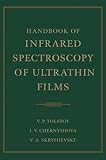Handbook of infrared spectroscopy of ultrathin films / Valeri P. Tolstoy, Irina V. Chernyshova, Valeri A. Skryshevsky.
Publication details: Hoboken, N.J. : Wiley-Interscience, ©2003.Description: 1 online resource (xxiv, 710 pages) : illustrationsContent type:- text
- computer
- online resource
- 0471461830
- 9780471461838
- 047135404X
- 9780471354048
- 047123432X
- 9780471234326
- 621.38152 22
- QC176.84.O7 T65 2003eb
Includes bibliographical references and index.
Cover -- CONTENTS -- Preface -- Acronyms and Symbols -- Introduction -- 1 Absorption and Reflection of Infrared Radiation by Ultrathin Films -- 1.1. Macroscopic Theory of Propagation of Electromagnetic Waves in Infinite Medium -- 1.2. Modeling Optical Properties of a Material -- 1.3. Classical Dispersion Models of Absorption -- 1.4. Propagation of IR Radiation through Planar Interface between Two Isotropic Media -- 1.4.1. Transparent Media -- 1.4.2. General Case -- 1.5. Reflection of Radiation at Planar Interface Covered by Single Layer -- 1.6. Transmission of Layer Located at Interface between Two Isotropic Semi-infinite Media -- 1.7. System of Plane ... Parallel Layers: Matrix Method -- 1.8. Energy Absorption in Layered Media -- 1.8.1. External Reflection: Transparent Substrates -- 1.8.2. External Reflection: Metallic Substrates -- 1.8.3. ATR -- 1.9. Effective Medium Theory -- 1.10. Diffuse Reflection and Transmission -- Appendix -- References -- 2 Optimum Conditions for Recording Infrared Spectra of Ultrathin Films -- 2.1. IR Transmission Spectra Obtained in Polarized Radiation -- 2.2. IRRAS Spectra of Layers on Metallic Surfaces ('Metallic' IRRAS) -- 2.3. IRRAS of Layers on Semiconductors and Dielectrics -- 2.3.1. Transparent and Weakly Absorbing Substrates ('Transparent' IRRAS) -- 2.3.2. Absorbing Substrates -- 2.3.3. Buried Metal Layer Substrates (BML-IRRAS) -- 2.4. ATR Spectra -- 2.5. IR Spectra of Layers Located at Interface -- 2.5.1. Transmission -- 2.5.2. Metallic IRRAS -- 2.5.3. Transparent IRRAS -- 2.5.4. ATR -- 2.6. Choosing Appropriate IR Spectroscopic Method for Layer on Flat Surface -- 2.7. Coatings on Powders, Fibers, and Matte Surfaces -- 2.7.1. Transmission -- 2.7.2. Diffuse Transmittance and Diffuse Reflectance -- 2.7.3. ATR -- 2.7.4. Comparison of IR Spectroscopic Methods for Studying Ultrathin Films on Powders -- References -- 3 Interpretation of IR Spectra of Ultrathin Films -- 3.1. Dependence of Transmission, ATR, and IRRAS Spectra of Ultrathin Films on Polarization (Berreman Effect) -- 3.2. Theory of Berreman Effect -- 3.2.1. Surface Modes -- 3.2.2. Modes in Ultrathin Films -- 3.2.3. Identification of Berreman Effect in IR Spectra of Ultrathin Films -- 3.3. Optical Effect: Film Thickness, Angle of Incidence, and Immersion -- 3.3.1. Effect in'Metallic' IRRAS -- 3.3.2. Effect in'Transparent' IRRAS -- 3.3.3. Effect in ATR Spectra -- 3.3.4. Effect in Transmission Spectra -- 3.4. Optical Effect: Band Shapes in IRRAS as Function of Optical Properties of Substrate -- 3.5. Optical Property Gradients at Substrate ... Layer Interface: Effect on Band Intensities in IRRAS -- 3.6. Dipole ... Dipole Coupling -- 3.7. Specific Features in Potential-Difference IR Spectra of Electrode ... Electrolyte Interfaces -- 3.7.1. Absorption Due to Bulk Electrolyte -- 3.7.2. (Re)organization of Electrolyte in DL -- 3.7.3. Donation/Backdonation of Electrons -- 3.7.4. Stark Effect -- 3.7.5. Bipolar Bands -- 3.7.6. Effect of Coadsorption -- 3.7.7. Electronic Absorption -- 3.7.8. Optical Effects -- 3.8. Interpretation of Dynamic IR Spectra: Two-Dimensional Correlation Analysis -- 3.9. IR Spectra of Inhomogeneous Films and Films on Powders and Rough Surfaces. Surface Enhancement -- 3.9.1. Manifestati.
Because of the rapid increase in commercially available Fourier transform infrared spectrometers and computers over the past ten years, it has now become feasible to use IR spectrometry to characterize very thin films at extended interfaces. At the same time, interest in thin films has grown tremendously because of applications in microelectronics, sensors, catalysis, and nanotechnology. The Handbook of Infrared Spectroscopy of Ultrathin Films provides a practical guide to experimental methods, up-to-date theory, and considerable reference data, critical for scientists who want to measure and.
Print version record.
There are no comments on this title.

